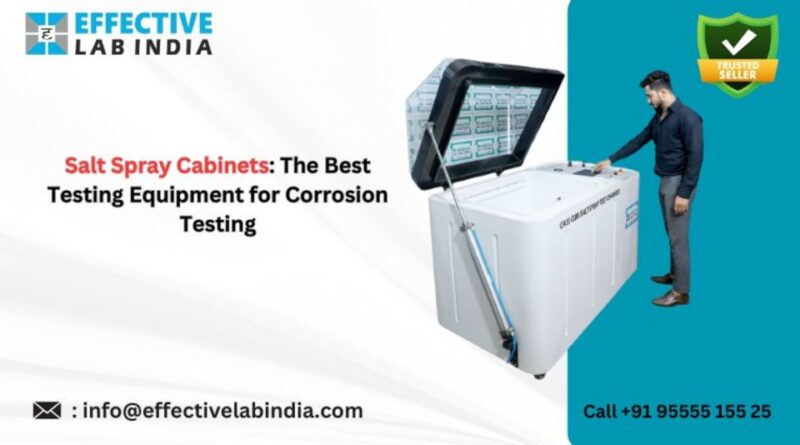The Best Testing Equipment for Corrosion Testing
Natural processes like corrosion may cause damage to metals and other materials, eventually resulting in their destruction. This is particularly challenging for sectors like construction, aircraft, and automotive where material integrity is essential. Corrosion testing is necessary for the prevention of material quality failures. Salt spray testing is a dependable and common approach among the many accessible procedures. Salt spray cabinets, specialised equipment made to mimic corrosive conditions and evaluate material durability, and are the basis of this testing methodology.
Understanding Corrosion Testing
Materials are exposed to environments that speed up the corrosion process as part of corrosion testing. This makes it possible for researchers and technology professionals to assess the performance of various materials and coatings in harsh environments. The outcomes of these tests are essential for choosing materials that can resist particular circumstances, increasing product longevity and lowering maintenance costs.Importance of Corrosion Testing in Industry
Materials that can withstand corrosion are essential to several industries, including aerospace, automotive, marine, and construction. Predicting a material’s behaviour under adverse conditions over time helps businesses guarantee cost-effectiveness, safety, and dependability. These industries can prevent unanticipated failures that might result in expensive repairs, safety risks, or even fatalities by performing corrosion testing.Overview of Salt Spray Cabinets
Materials are exposed to a salty mist in controlled environments known as salt spray cabinets, salt fog, or salt spray chambers. The purpose of this mist is to mimic the corrosive conditions present in maritime regions and locations with elevated amounts of salt contamination. Manufacturers have the capability to assess the overall durability and efficacy of protective coatings by putting products within these cabinets.How Do Salt Spray Cabinets Work?
For the reason to create a fine mist, salt spray cabinets work by atomising a saltwater solution, usually sodium chloride. The test samples within the cabinet are then constantly sprayed with this mist. Testing conditions may be made uniform and reproducible by carefully regulating the salt solution’s temperature, humidity, and concentration. Several hours to several weeks may pass throughout the exposure period, contingent upon the test’s specifications.Key Applications of Salt Spray Cabinets
Salt spray cabinets are widely used in various industries for testing: Automotive Components: Ensuring that car parts, especially those exposed to the elements, can withstand long-term exposure to corrosive conditions. Coatings: Evaluating the effectiveness of paints, galvanizing, and other protective coatings. Metal Alloys: Testing the durability of different metal compositions under corrosive stress. Marine Equipment: Assessing the resistance of materials used in boats, ships, and offshore platforms.Features of the Best Salt Spray Cabinets
- Fiber Reinforced Non Rusted Body
- Pneumatic Door Opening
- Digital Microprocessor-Based PID Control Panel
- Temperature Range – 35°C/48°C
- Fog Collection Out-Side
- Humidifier Air Saturator in Build
- CASS & NSS Both Tests can be performed
- Air Purging System (Manual)
- Transparent canopy
Technical Specifications of Salt Spray Chamber
- Models: Salt Spray Chamber(HMI)
- Capacity: 250 Liters, 450 Liters, 1000 Liters
- Inner Dimensions (mm): 780X620X720(250LTR), 950x700x720(450LTR), 1500x960x710(1000LTR)
- Outer Dimensions (mm): 1540x1070x1300(250LTR), 1800x1250x1250(450LTR), 2370x1400x1350(1000LTR)
- Display: HMI Based touchscreen 7-inch
- Chamber Temp Range: Ambient to 40∘C
- Temperature Range of the Test Chamber: 35∘C ± 2∘C
- Minimum Temperature in the Chamber: 0.1∘C
- Repeatability of Chamber Temperature: ± 2∘C
- Temperature Range for Air Saturator: 40∘C – 49∘C
- Lowest Count for Air Saturator Temperature: 0.1∘C
- Repeatability of Air Saturator Temperature: ± 2∘C
- Power: 220V, Single phase, 50 Hz, 15 A
- pH Value of Salt Solutions: 6.5 to 7.2 pH
- Temperature Control: Inbuilt PID Temperature Controller
- Timer (Hour meter): 6 digits
- Test Air Pressure: 0.7Kg/cm2 – 1.2Kg/cm2
- Air Regulator: 0 to 30 psi
- Air Saturator water Level low alarm: Yes
- Fog Collection Funnel: 1
- Door Opening: Hydraulic
- Air Saturator Auto Refilling: Yes
- Material: Fibre Glass
- Over Temperature Alarm: Yes
- Reservoir float valve: Yes

